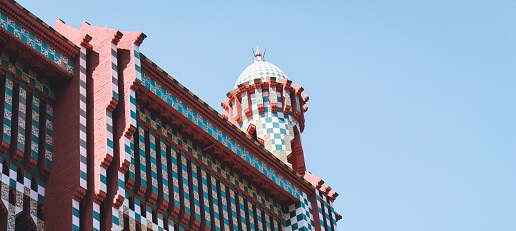
THR's opinion
A Case Study in Attraction Development - Antoni Gaudi's Casa Vicens
The city of Barcelona has always boasted an abundance of offerings for its visitors, not least its myriad architectural masterpieces, the most dazzling of which date from the “Modernisme” period.
While many of the Modernist attractions – think the Sagrada Familia, Casa Batlló, and La Pedrera – have long been on standard tourist itineraries, there are several hidden gems that for a number of reasons have not always been available to the general public.
By far the most impressive of these sites to recently appear on the visitor map is Casa Vicens, Modernist master architect Antoni Gaudi’s first major residential commission.
A slow percolation before opening to the public
Casa Vicens opened to visitors in 2017 after a massive 3-year renovation. While the eye-popping façade and other sections of the exterior were always visible to the street-side public, it wasn’t until recently that visitors were allowed entry to marvel at another of Gaudi’s masterpieces.
The UNESCO World Heritage site (as of 2007) was received by the public with great enthusiasm, steadily increasing visitor numbers year-on-year and then, well, Covid. Despite the pandemic setback, the showpiece from Gaudi’s “oriental” period is in 2022 set to break even the impressive 2019 visitor numbers.
I met with Emili Masferrer i Fons, General Manager and CEO of Casa Vicens, for a detail-packed tour and an insightful conversation into the Casa Vicens visitor and attraction strategy, and especially how the house differentiates from its more established Barcelona architecture peer destinations.
What’s the attraction of the attraction?
The house showcases classic influences of modernism, including an endless number of nature motifs in the architectural details, both indoors and outdoors, Arab technical elements such as screens and water features, and an open floor-plan design that facilitated the house’s original intention as a summer residence and captured any breezes that wafted through the space.
After decades of ownership by the Jover family, the house was sold to MoraBanc in 2014. MoraBanc, a family-owned financial services business headquartered in Andorra, acquired the house in alignment with its values of heritage and tradition for the long-term well-being of the communities it serves, preserving history and culture for multiple generations.
Casa Vicens, both through luck and intention, enjoys several notable points of differentiation from its better-known peers in Barcelona:
- Central but slightly removed location: Casa Vicens’ location in the heart of the eclectic Gracia area is an asset in itself, as the broader neighborhood has a wealth of options for visitors to explore, often included in more “off-the-beaten-path” itineraries.
- Newcomer to the scene: Casa Vicens hasn’t yet appeared in as many guidebooks or on as many must-visit lists, and is therefore a generally far less crowded tour than its downtown competitors, making for a much more pleasant tourist visit.
- “Second visit” attraction: As well, given its new-ish status, the Casa Vicens visitor strategy originally contemplated a value proposition more attractive to “second visits” to Barcelona, that is to visitors who may have previously been to the city and seen the more standard “Top 10” attractions, but who have now returned and are looking for something new to see. That said, as Mr. Masferrer i Fons noted, Casa Vicens is now appearing on many first-visit itineraries as well.
- Lean operations team: Run by a core team of four staffers, Casa Vicens has successfully partnered with a number of external service providers to manage many of the non-core activities of the house, allowing overall staff numbers to expand and contract depending on seasonality and visitor-number expectations.
- Self-guided tours: Unlike other attractions of its type that channel visitors along pre-determined pathways through the space, Casa Vicens has an open floorplan that allows visitors to wander at will, though with the support of a downloadable audio guide. This strategy frees visitors from a preconceived tour of the house, empowering them to create their own experience.
- More house than museum: All of the exhibit labels as well as models and historical descriptions of the various facets of the house are reserved for the top floor of the building – usually the last part of a visit - lending the rest of the space a sensation of passing through someone’s home, rather than through a curated exhibition.
- Pricing strategy: The average ticket price is relatively economical compared to similar Barcelona peer attractions.
In sum
All of the above attraction-development strategies have led to double-digit growth for Casa Vicens, which also hosts a small café and spaces for corporate events. The house is remarkably well-run, and through continued intelligent stewardship doubtless on course to become one of the must-see stops of any Barcelona visit and a successful model for attractions management.
Guest article by THR Senior Marketing Director Benjamin Rhatigan.